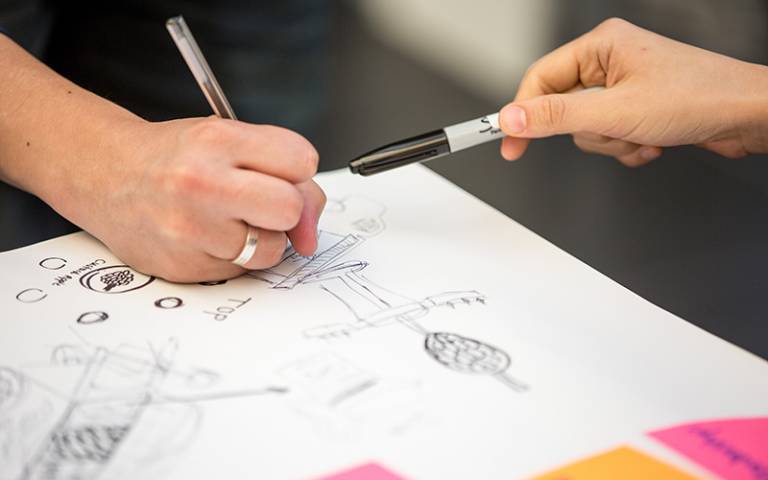What is inclusive and collaborative civic innovation and why we are exploring it?
16 August 2022
UCL and the Greater London Authority (GLA) are working together on civic innovation policy and programmes. In this article UCL researchers explore what inclusive and collaborative civic innovation means and how it can tackle complex urban challenges.

Julie McLaren (UCL), Gemma Moore (UCL), Giuseppe Salvia (Brunel), Almira Lardizabel Hussain (GLA), Max Smith (GLA) and Juan Pablo Astolfo (GLA)
The Greater London Authority (GLA) has been experimenting with challenge-based innovation programmes as part of its ChallengeLDN initiative. This includes the Civic Innovation Fund (CIC) 2018-19, the Mayor’s Resilience Fund (MRF) in 2020 and the Designing London’s Recovery Programme (DLRP) in 2021-22. Each initiative has its specific aims and objectives though all are focused on solving civic or urban challenges through a programme approach.
UCL is leading the Complex Urban Systems for Sustainability and Health (CUSSH) research programme, a Wellcome Trust-funded, trans-disciplinary project on urban systems for sustainability and health. Researchers from CUSSH, from a variety of disciplinary backgrounds (e.g. design, innovation, systems thinking, urban health and evaluation) have been working with the Greater London Authority as a learning partner on their civic innovation policy and programmes. This work has included (amongst other things) co-creating a theory of change for the DLRP (alongside other forms of support), an evaluation of their other civic innovation programmes (CIC and MRF) and, more recently, working with the GLA to explore learning around how challenge-based programmes can be inclusive and collaborative.
For the latter, researchers and policy makers from the GLA have worked together to scope the potential for adapting Challenge programmes to a more inclusive and collaborative model. This has included a combination of desk research and discussions with others working in this field – including researchers, practitioners, public sector officials. This blog provides some insights and reflections from our desk research.
Why are we exploring inclusive and collaborative civic innovation?

Innovation provides an engine for systemic change. However, tackling the complex urban problems we see around us requires new ways of thinking about innovation and a more inclusive model of what innovation is, who is involved and who benefits. New collaborative ways of working can challenge and change the systems in which these problems are embedded.
Innovation policy and practice has been undergoing a transformation. Whereas in the past city-level innovation programmes have primarily focused on enhancing local economic performance, civic leaders have become increasingly interested in leveraging innovation to address social and environmental challenges (such as net zero or addressing health inequalities). These are recognised as complex problems, experienced differently by different stakeholder groups including within communities themselves. These problems require an understanding of how social issues interact with political influences and technological solutions, behavioural changes and regulation. A shift toward more inclusive innovation acknowledges that innovation policy in a free-market context over several decades has had uneven effects and an inclusive and collaborative approach, which includes those previously marginalised from the process, brings together the range of stakeholders needed to unlock solutions.
This emphasis on problem-focused and inclusive, participatory approaches presents new challenges to public administrations for how best to support and enable innovation directed at a particular agenda or problem in an urban system that is highly complex. Public bodies aren’t alone in this challenge. Civic innovation is a team sport after all, it requires cooperation and coordination across a set of organisations in a given place – government, business, civil society, research - to create the conditions for innovation. A recent report on making the economy more inclusive suggests that no single innovation district or area in the UK has perfected the practice of inclusive innovation.
Challenge-based innovation programmes have become a popular format for connecting entrepreneurial activity with problems faced by particular cities, groups etc. However, whilst these programmes are pretty effective at connecting innovative ideas with well-defined problems, such programmes are being tested when it comes to navigating the complexity involved in implementing those ideas. Furthermore, the attraction or draw of such programmes is the joining-up or coordinating role needed to solve deeper social challenges - but this itself is a messy, value-laden process.
The foundations of Challenge programmes may still hold potential for addressing more complex problems, especially if they are practised collaboratively. This potential underlies the question we are keen to explore further: can current models of challenge-led innovation programmes be adapted to be more inclusive and collaborative and what would that entail? Our starting point is to review case studies of inclusive and collaborative innovation, whilst discussing with innovation practitioners the barriers and opportunities they have faced, alongside delving into the values that underpin their approach.
What do we mean when we talk about inclusive and collaborative civic innovation?

The terms “open”, “inclusive” and “collaborative” are used often in research, reports and strategies about civic innovation, sometimes interchangeably or in combination (i.e. to emphasise different aspects of inclusive practice or more generally to refer to co-designed and co-produced innovation). We looked at some of the origins of these terms as well as how they are currently used and summarised (summarised in Figure 1).
Figure 1. Open, inclusive and collaborative innovation: origins & core elements
While there are common characteristics amongst these approaches to innovation (such as the prevalence of design thinking, agile methodologies and the opening up of data), there is also a shift in focus between ‘open’, ‘inclusive’ and ‘collaborative’ innovation. What we found, however, is a high degree of ambiguity in how the terms are used and to what end. This is in line with others who have written about the multiple and inconsistent meanings of inclusive innovation at city level which can be both useful and problematic.
Our take-away from this review was that there are multiple drivers at play in inclusive and collaborative innovation. Reported motivations included: a desire to be transparent wanting to work in the ‘open’, to encourage participation of varying degrees; ambitions to share power with groups who are marginalised from the innovation processes; driven by a need to effect change in a system, the need to find new avenues for business growth and economic development.
This range of drivers highlights the multiplicity and multifunctionality of the term ‘inclusive and collaborative innovation’. Most often there are combinations of these motivations in play, as we might expect in projects and programmes that are seeking to experiment with different ways of delivering innovation that is fairer, more holistic, and more sustainable. Our sense is that in delivering more inclusive and collaborative innovation programmes, it is vital to be open about what is driving the approach and to come to a shared understanding with those involved in the process about what is being delivered and why.
Based on the review of research and case studies in this field of innovation, we came together and drew up the following working definition of inclusive and collaborative innovation to inform the GLA’s future Challenge programme activity:
A multi-actor approach to innovation that brings diverse perspectives together to actively define, understand and solve challenges experienced in the local context, using a range of tools and knowledge, and creating and sharing value as an integral part of the process.
Our definition reflects the different dimensions of an inclusive and collaborative approach: inclusion and collaboration in the strategic direction-setting (including in how challenges are chosen), in the process of innovation delivery (via a broadening of the innovation community), and in the benefits or distribution of the value created by the innovation.
Common features of inclusive and collaborative civic innovation approaches
There are numerous examples of civic innovation initiatives that are problem-focused and working to be inclusive and collaborative in approach. We looked across a sample of these to inform our thinking, looking at features of such an approach and the roles of local government/public administrations in those initiatives. The examples we explored were varied in terms of geography (e.g. examples based in Europe, North America, Africa) stakeholders leading or convening the process (e.g local and regional government, non-profit organisations, research institutions including universities) and challenges addressed.
Two such examples we which combined inclusive and collaborative practice in a challenge-led civic innovation were:

Their process is focused around three activities: i) identifying needs with communities that have been exposed to systemic inequality to co-create urban innovation; ii) partnering with city agencies to bring a community-centred approach to addressing broad agency/Mayoral priorities, and build agency-community feedback loops that foster trust (and power) over new technologies; and iii) launching global innovation challenges and deploys technology pilots on public infrastructure to accelerate local entrepreneurship.

Despite clear differences, both of these examples support a process of collective action to address problems identified with communities. Some of the common features of these examples, and the others we looked at, were:
- innovation focused towards social, environmental and economic goals (i.e. broader than a focus on economic development alone)
- the lead organisation playing an active role in providing a framework and/or “holding” together an inclusive and collaborative space for inclusive and collaborative innovation practice
- a combination of a “systems” layer which convenes the relevant stakeholders – including those with the power to act (including community members/representatives) – alongside or interwoven with a deeper engagement process with the communities/neighbourhood
- communities (e.g. geographical communities, communities of interest, etc) having shared ownership of the problem and decisions about possible solutions
- the process being balanced towards the shaping and sustainability of complex innovation systems (in contrast to initiatives that might be more narrowly focused on business opportunities or technological solutions)
- learning and evaluation being embedded in the process and informing a more agile and iterative approach to innovation.
What are our insights so far?
How we (and others) think about innovation is changing. Previous policy narratives about innovation have been dominated by economic growth, but a broader discussion is now evident in research and practice about how to leverage innovation towards social and environmental transitions in complex systems. This involves a rethink about what civic innovation is, what it seeks to change and who needs to be involved in deciding and directing that.
Looking at definitions of open, inclusive and collaborative innovation and how they are used in the practice of innovation programmes, it is clear there is considerable fuzziness in the terms making it important to look at the motivations and values that sit behind them.
We have sought to define what we mean by inclusive and collaborative innovation in a way that is stretching but can also be applied to thinking about how Challenge programmes, being led by organisations like the GLA, might evolve to become more inclusive and collaborative in their strategy, their process and their outcomes.
This work has led us to think more about the practice of inclusive and collaborative innovation, the challenges faced and also the values held by those individuals and groups leading inclusive innovation.
 Close
Close

